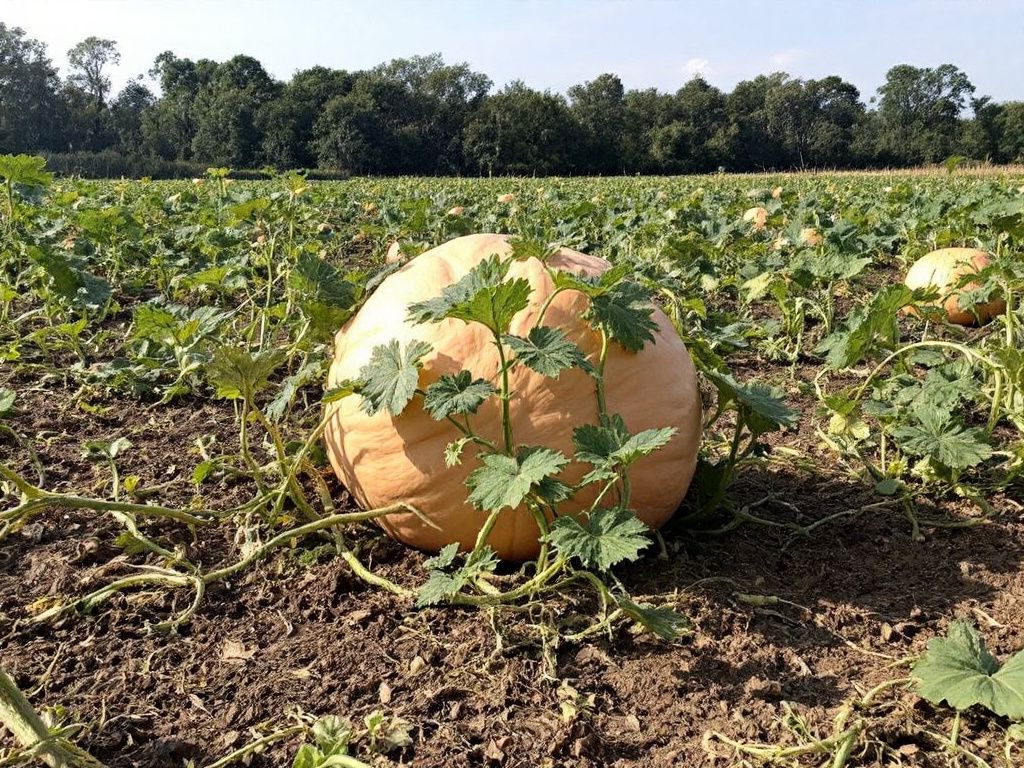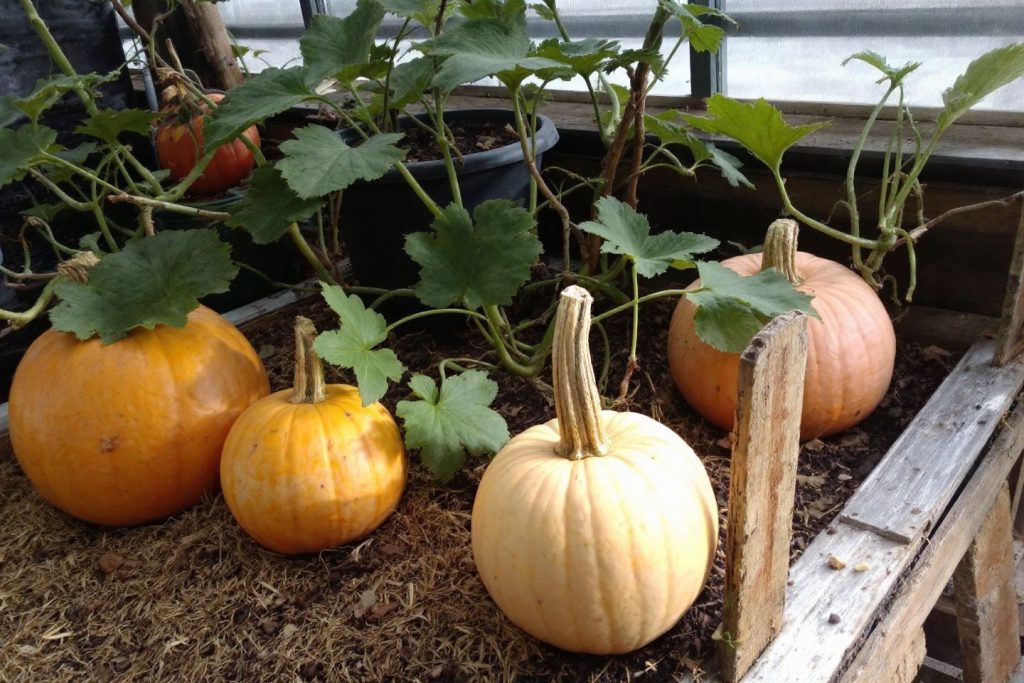Structural and Safety Concerns
Supporting the Weight
As pumpkins grow heavier, they require support.
- Structural Limitations: Floors and supports may not handle the weight of a giant pumpkin, especially in upper stories or on non-reinforced surfaces.
- Safety Risks: The risk of accidents increases with the pumpkin’s size, as the heavy fruit could shift or break its support structure, causing damage or injury.
Indoor Damage
The sheer size of giant pumpkins can cause damage to indoor spaces.
- Pressure on Surfaces: The weight of a giant pumpkin can damage floors, particularly on upper stories, and may even lead to structural issues.
- Space Obstruction: Large vines and fruit can obstruct walkways, exits, and other parts of indoor spaces, making it inconvenient and potentially hazardous.
Pest and Disease Management
Increased Vulnerability Indoors
Indoor-grown pumpkins can suffer from various pests and diseases, which are harder to manage indoors without natural environmental checks.
- Fungal Diseases: High indoor humidity can promote mold and mildew, which are detrimental to pumpkin health.
- Pest Infestations: Pests like aphids and spider mites thrive in indoor conditions due to the lack of natural predators, leading to higher vulnerability.
Refer to our guide on Preventing Pests in Indoor Gardens for more information on managing these issues effectively.
Practical Alternatives
Growing Smaller Pumpkin Varieties
For indoor gardening enthusiasts, cultivating smaller pumpkin varieties offers a more practical alternative.
- ‘Jack Be Little’: This miniature pumpkin grows well in containers and produces small, decorative fruits.
- Bush Varieties: Compact bush-type pumpkins require less space and are manageable indoors, though they still need substantial light.
Focus on Suitable Indoor Crops
Instead of pumpkins, consider plants that are well-suited for indoor gardening.
- Leafy Greens: Vegetables like lettuce, spinach, and herbs thrive indoors and require less space and maintenance than giant pumpkins.
- Dwarf Fruit Trees: Some fruit trees are specifically bred for indoor growth, offering fresh produce year-round in small spaces.
Explore our list of Best Plants for Indoor Gardening for more ideas on creating a thriving indoor garden.
Conclusion
The dream of growing giant pumpkins indoors faces insurmountable challenges due to space limitations, environmental control issues, and the immense demands of these colossal plants.
Key Takeaways
- Spatial Limitations: Indoor spaces simply cannot accommodate the size requirements of giant pumpkins.
- Environmental Controls: Managing light, temperature, and humidity indoors on the scale required for giant pumpkins is difficult and costly.
- Nutritional Needs: The nutrient requirements of giant pumpkins exceed what is feasible to provide in an indoor setting.
- Health and Safety Risks: Supporting the large weight and size of a giant pumpkin inside a home poses significant structural and safety concerns.
For those passionate about growing giant pumpkins, participating in community gardens or collaborating with local farmers might be a more viable route to success.
Join the Majestic Gardening Community
Have you attempted to grow large plants indoors? Share your experiences, challenges, and successes with us.
- Comment Below: We welcome your stories and questions.
- Connect with Us: Follow us on Instagram and Facebook for more gardening insights.
Happy gardening,
The Majestic Gardening Team
This article is part of our series on gardening challenges. Explore more to enhance your green thumb.
Introduction
Every autumn, gardening enthusiasts marvel at the sight of giant pumpkins weighing hundreds or even thousands of pounds at fairs and competitions. The idea of cultivating such massive gourds is enticing, leading some to wonder if it’s possible to grow them indoors. However, the reality is that growing giant pumpkins indoors is nearly impossible due to a combination of environmental, spatial, and biological factors. At Majestic Gardening, we delve into the reasons behind this challenging endeavor and explore why indoor cultivation of giant pumpkins defies practicality.
Understanding Giant Pumpkins
The Biology of Behemoths
Giant pumpkins (Cucurbita maxima) are the result of selective breeding and optimal growing conditions.
- Genetic Potential: Varieties like the ‘Atlantic Giant’ have been bred for size.
- Growth Rate: These pumpkins can gain up to 50 pounds in a single day under ideal conditions.
Space Requirements
The vast size of giant pumpkins isn’t limited to the fruit itself.
- Vine Spread: The plants can sprawl over an area of 1,000 square feet (93 square meters).
- Root System: A deep and expansive root network is essential for nutrient uptake.
Environmental Challenges of Indoor Growth

Limited Space
Indoor environments simply cannot accommodate the space giant pumpkins require.
- Vertical and Horizontal Growth: Ceilings limit vertical growth, while floors restrict horizontal spread.
- Container Size: Suitable containers would need to be enormous and impractical for indoor spaces.
Insufficient Light
Giant pumpkins need ample sunlight to fuel their growth.
- Full Sun Exposure: They require at least 6-8 hours of direct sunlight daily.
- Artificial Lighting Limitations: Mimicking sunlight intensity indoors is costly and energy-intensive.
For more on lighting challenges, read Understanding Plant Light Requirements.
Temperature and Humidity Control
Maintaining optimal conditions indoors is difficult.
- Temperature Fluctuations: Giant pumpkins thrive between 65°F and 85°F (18°C – 29°C).
- Humidity Levels: Balancing humidity to prevent diseases while meeting the plant’s needs is tricky.
Nutritional Demands

Massive Nutrient Intake
The colossal growth of giant pumpkins necessitates a significant supply of nutrients.
- Soil Fertility: Requires rich, organic soil with continuous amendments.
- Feeding Schedule: Demands frequent fertilization, sometimes daily, with high amounts of nitrogen, phosphorus, and potassium.
Soil Volume
An indoor pot cannot hold enough soil to support a giant pumpkin.
- Root Expansion: Restricted roots impede growth and health.
- Moisture Management: Large soil volumes are needed to retain adequate moisture without waterlogging.
Pollination Obstacles
Flowering and Pollination Needs
Giant pumpkins produce large male and female flowers that need pollination.
- Lack of Pollinators: Indoor environments lack bees and other natural pollinators.
- Hand Pollination: Requires meticulous timing and technique, often with limited success.
Learn about pollination in our article on The Importance of Pollinators in Gardening.
Structural and Safety Concerns
Supporting the Weight
As pumpkins grow heavier, they require support.
- Structural Limitations: Floors and supports may not handle the weight of a giant pumpkin, especially in upper stories or on non-reinforced surfaces.
- Safety Risks: The risk of accidents increases with the pumpkin’s size, as the heavy fruit could shift or break its support structure, causing damage or injury.
Indoor Damage
The sheer size of giant pumpkins can cause damage to indoor spaces.
- Pressure on Surfaces: The weight of a giant pumpkin can damage floors, particularly on upper stories, and may even lead to structural issues.
- Space Obstruction: Large vines and fruit can obstruct walkways, exits, and other parts of indoor spaces, making it inconvenient and potentially hazardous.
Pest and Disease Management
Increased Vulnerability Indoors
Indoor-grown pumpkins can suffer from various pests and diseases, which are harder to manage indoors without natural environmental checks.
- Fungal Diseases: High indoor humidity can promote mold and mildew, which are detrimental to pumpkin health.
- Pest Infestations: Pests like aphids and spider mites thrive in indoor conditions due to the lack of natural predators, leading to higher vulnerability.
Refer to our guide on Preventing Pests in Indoor Gardens for more information on managing these issues effectively.
Practical Alternatives
Growing Smaller Pumpkin Varieties
For indoor gardening enthusiasts, cultivating smaller pumpkin varieties offers a more practical alternative.
- ‘Jack Be Little’: This miniature pumpkin grows well in containers and produces small, decorative fruits.
- Bush Varieties: Compact bush-type pumpkins require less space and are manageable indoors, though they still need substantial light.
Focus on Suitable Indoor Crops
Instead of pumpkins, consider plants that are well-suited for indoor gardening.
- Leafy Greens: Vegetables like lettuce, spinach, and herbs thrive indoors and require less space and maintenance than giant pumpkins.
- Dwarf Fruit Trees: Some fruit trees are specifically bred for indoor growth, offering fresh produce year-round in small spaces.
Explore our list of Best Plants for Indoor Gardening for more ideas on creating a thriving indoor garden.
Conclusion
The dream of growing giant pumpkins indoors faces insurmountable challenges due to space limitations, environmental control issues, and the immense demands of these colossal plants.
Key Takeaways
- Spatial Limitations: Indoor spaces simply cannot accommodate the size requirements of giant pumpkins.
- Environmental Controls: Managing light, temperature, and humidity indoors on the scale required for giant pumpkins is difficult and costly.
- Nutritional Needs: The nutrient requirements of giant pumpkins exceed what is feasible to provide in an indoor setting.
- Health and Safety Risks: Supporting the large weight and size of a giant pumpkin inside a home poses significant structural and safety concerns.
For those passionate about growing giant pumpkins, participating in community gardens or collaborating with local farmers might be a more viable route to success.
Join the Majestic Gardening Community
Have you attempted to grow large plants indoors? Share your experiences, challenges, and successes with us.
- Comment Below: We welcome your stories and questions.
- Connect with Us: Follow us on Instagram and Facebook for more gardening insights.
Happy gardening,
The Majestic Gardening Team
This article is part of our series on gardening challenges. Explore more to enhance your green thumb.







